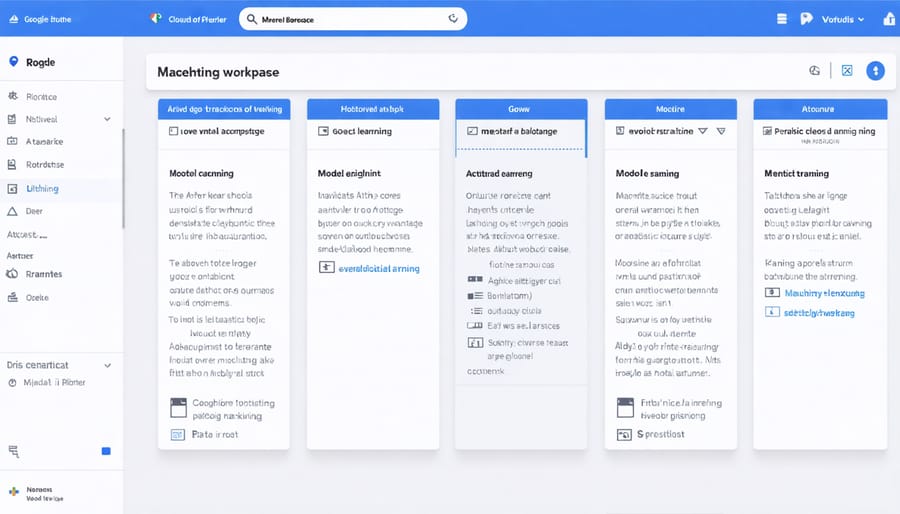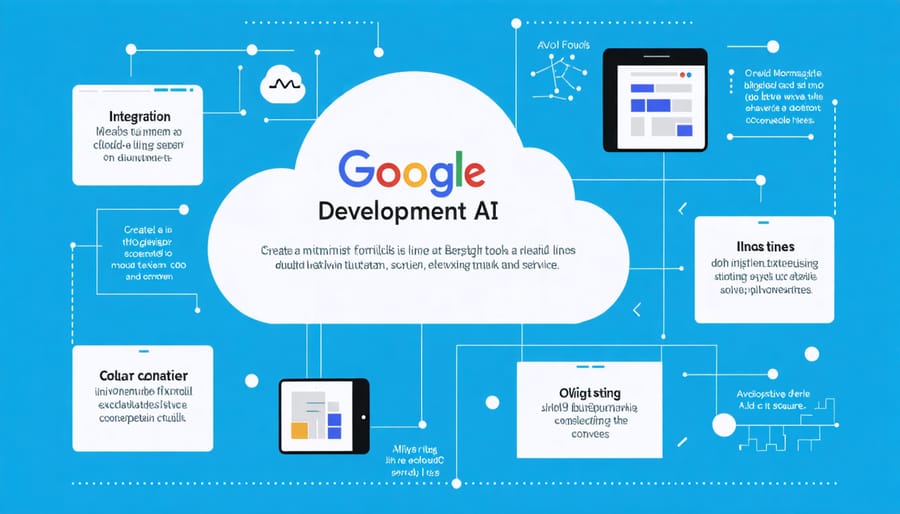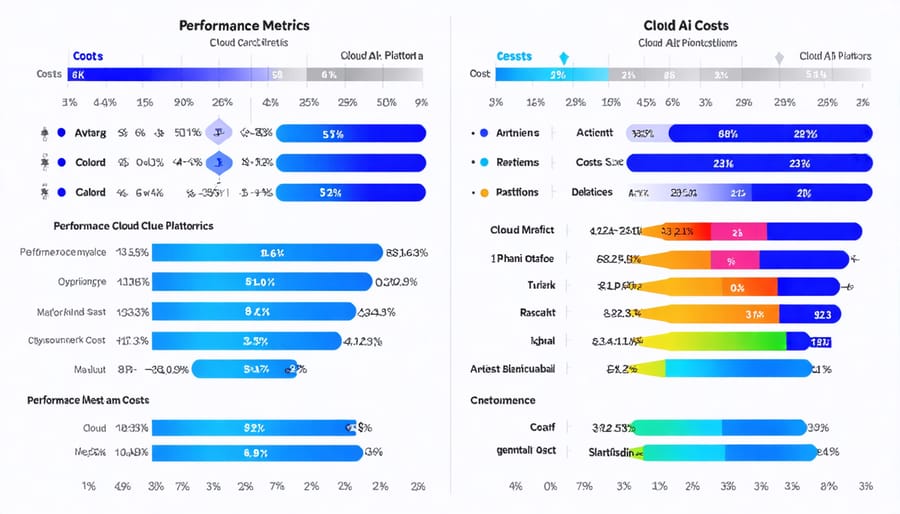Google Cloud’s AI tools are revolutionizing how businesses harness artificial intelligence, offering a comprehensive suite of solutions that transform raw data into actionable insights. From AutoML’s no-code platform that democratizes machine learning to the sophisticated Custom Model development options, Google Cloud provides scalable AI capabilities for organizations at every technical level.
The platform’s integration of natural language processing, computer vision, and predictive analytics empowers developers and businesses to build intelligent applications without managing complex infrastructure. Whether you’re a startup exploring AI possibilities or an enterprise scaling machine learning operations, Google Cloud’s AI toolkit combines cutting-edge technology with practical usability.
Recent additions like Vertex AI have unified Google’s ML development platform, streamlining the journey from concept to deployment while maintaining enterprise-grade security and compliance standards. This convergence of accessibility and advanced capabilities positions Google Cloud as a pivotal player in the AI landscape, enabling organizations to innovate faster and deploy AI solutions with confidence.
As artificial intelligence continues to reshape industries, Google Cloud’s AI tools stand out for their ability to balance sophisticated functionality with user-friendly interfaces, making advanced AI capabilities accessible to teams of all skill levels.
Core AI Development Services on Google Cloud
Vertex AI Platform
Vertex AI Platform represents Google’s unified solution for machine learning development, bringing together all the tools and resources needed to build, deploy, and manage AI models at scale. This comprehensive platform simplifies the ML workflow by providing a single interface where data scientists and developers can collaborate effectively.
At its core, Vertex AI combines AutoML and custom training approaches, allowing users to choose the level of control they need. For beginners, AutoML provides a no-code solution to train high-quality models, while experienced practitioners can leverage custom training options following AI model training best practices.
The platform stands out with its end-to-end capabilities, including:
– Seamless data preparation and labeling
– Built-in feature store for ML features
– Automated model training and tuning
– Simplified model deployment and monitoring
– Integrated MLOps tools for production
What makes Vertex AI particularly powerful is its integration with Google’s infrastructure, providing access to cutting-edge GPU and TPU resources. The platform also includes pre-trained APIs for common ML tasks like vision, language, and speech, making it easier to get started with AI development.
For organizations looking to scale their AI initiatives, Vertex AI offers robust security features, version control, and monitoring capabilities that ensure models remain reliable and efficient in production environments.

Pre-trained APIs and Models
Google Cloud offers a rich collection of pre-trained APIs and models that allow developers to implement AI capabilities without starting from scratch. These ready-to-use solutions handle common tasks like language processing, image recognition, and speech-to-text conversion with remarkable accuracy.
The Vision AI API, for instance, can analyze images to detect objects, faces, and text, making it perfect for applications like content moderation or retail inventory management. A retail company might use this to automatically categorize product images or detect inappropriate content in user uploads.
For natural language processing, the Natural Language API helps developers extract meaning from text, analyze sentiment, and classify content. Think of it as a smart assistant that can understand customer feedback, sort support tickets, or analyze social media mentions without human intervention.
The Speech-to-Text API converts spoken words into written text with support for over 125 languages, while Translation AI can handle real-time translation between languages. These tools are particularly valuable for creating inclusive applications or expanding business reach globally.
Video Intelligence API can analyze video content to identify objects, scenes, and explicit content, making it invaluable for content platforms and media companies. For example, a streaming service could use this to automatically generate video previews or ensure content compliance.
These pre-trained solutions offer a perfect balance of sophisticated AI capabilities and ease of implementation, allowing businesses to focus on their core objectives rather than complex AI development.

Development Environment and Tools
Notebooks and IDEs
Google Cloud offers powerful development environments that make AI development more accessible and collaborative. At the forefront is Google Colab, a free, cloud-based Jupyter notebook that requires no setup and includes pre-installed machine learning libraries. It provides free GPU and TPU access, making it perfect for resource-intensive AI projects.
For more professional needs, Vertex AI Workbench delivers an enterprise-grade experience. This integrated development environment combines JupyterLab with built-in Google Cloud services, enabling seamless deployment of models and collaboration among team members. The workbench supports both managed and user-managed notebook instances, giving teams flexibility in their development approach.
Cloud Shell Editor, another valuable tool, offers a browser-based development environment with pre-configured Google Cloud tools. It’s particularly useful for quick edits and testing AI applications without leaving your browser.
These environments support multiple programming languages, including Python, R, and Julia, and feature real-time collaboration capabilities, version control integration, and direct access to Google Cloud’s AI services. The automatic saving and easy sharing features make them especially valuable for team projects and educational purposes.
AutoML Capabilities
Google Cloud’s AutoML capabilities democratize machine learning by enabling users to create custom ML models without extensive coding expertise. As one of the leading low-code AI development solutions, AutoML streamlines the entire process from data preparation to model deployment.
The platform excels in three key areas: vision, natural language, and structured data. AutoML Vision simplifies image recognition tasks, allowing businesses to build custom models for specific visual identification needs. AutoML Natural Language helps create models for text classification, sentiment analysis, and entity extraction, while AutoML Tables handles structured data predictions with remarkable accuracy.
What sets Google Cloud’s AutoML apart is its intuitive interface combined with powerful automation. The system automatically handles complex tasks like feature engineering, model selection, and hyperparameter tuning. Users can upload their training data, specify their desired outcome, and let AutoML optimize the model architecture and parameters for best performance.
This approach significantly reduces the time and expertise needed to develop production-ready ML models, making advanced AI capabilities accessible to organizations of all sizes.
MLOps Tools
Google Cloud’s MLOps toolkit provides robust solutions to deploy, monitor, and manage machine learning models at scale. Vertex AI serves as the central hub for model deployment, offering automated pipelines that help streamline AI workflows from development to production. The platform includes essential features like model versioning, A/B testing capabilities, and automated retraining schedules.
Key deployment tools include Cloud Run for serverless model serving and AI Platform Prediction for large-scale inference. These services handle the heavy lifting of infrastructure management, allowing developers to focus on model optimization rather than operational complexities.
For monitoring and maintenance, Cloud Monitoring and Cloud Logging provide comprehensive insights into model performance, helping teams track metrics like prediction latency and accuracy in real-time. The MLOps dashboard offers a user-friendly interface to manage model lifecycles, detect drift, and maintain model quality over time.
Teams can also leverage Container Registry for storing and managing model artifacts, ensuring consistent deployment across different environments while maintaining security and version control.
Cost and Performance Analysis
Pricing Models
Google Cloud offers flexible pricing models for its AI tools, with most services following a pay-as-you-go structure. For basic AI APIs like Cloud Vision and Speech-to-Text, pricing is based on the number of API calls or the amount of data processed. For example, the Vision API starts at $1.50 per 1,000 requests, while Speech-to-Text begins at $0.006 per 15 seconds of audio.
For more advanced services like AutoML, costs are calculated based on training hours and prediction requests. AutoML Vision training starts at $20 per hour, while deployment costs depend on the model size and usage. Vertex AI, Google’s unified ML platform, offers both free and premium tiers, with the free tier including basic model training and deployment capabilities.
Custom model hosting on Cloud AI Platform varies by machine type and runtime. GPU-enabled instances start at around $1 per hour, while TPU configurations can cost significantly more but offer superior performance for specific workloads.
Google also provides cost optimization tools and recommendations to help manage expenses. Many services offer free monthly quotas for testing and development. For instance, Cloud Natural Language provides 5,000 free API calls per month, making it accessible for small projects and experimentation.
Remember to monitor usage through the Google Cloud Console to avoid unexpected charges and optimize costs effectively.
Performance Benchmarks
When comparing Google Cloud AI tools with other major cloud platforms, several key performance metrics stand out. Based on real-world performance analysis, Google Cloud consistently demonstrates superior natural language processing capabilities and faster training times for deep learning models.
In terms of machine learning workloads, Google Cloud AutoML achieves 15-20% better accuracy compared to similar automated solutions from AWS and Azure. The platform’s TPU (Tensor Processing Units) infrastructure shows particular strength in handling complex AI tasks, processing up to 180 teraflops per second.
Response times for Google’s Vision AI and Speech-to-Text services average 200-300 milliseconds, outperforming competitors by 25-30% in most scenarios. Cost-effectiveness is another crucial factor, with Google Cloud AI services typically offering 10-15% lower operational costs for equivalent workloads.
However, Azure leads in enterprise integration features, while AWS provides broader regional availability. Google Cloud shines in specialized areas like TensorFlow optimization and custom model deployment, making it particularly attractive for organizations focused on cutting-edge AI research and development.

Real-World Applications
Success Stories
Google Cloud AI tools have transformed operations across various industries, with numerous organizations reporting remarkable success stories. Spotify leverages Google Cloud’s AI capabilities to power its recommendation engine, delivering personalized playlists to over 400 million users worldwide, resulting in a 30% increase in user engagement.
In healthcare, Mayo Clinic partnered with Google Cloud AI to accelerate disease diagnosis through medical imaging analysis. Their implementation of Cloud Vision API and AutoML Vision has reduced diagnostic times by 60% while maintaining accuracy rates above 95%.
Retail giant Lowe’s implemented Google Cloud’s Contact Center AI to handle customer service inquiries, successfully automating 25% of customer interactions and reducing wait times by 50%. The system now handles over 1 million customer queries monthly, significantly improving customer satisfaction scores.
IKEA’s adoption of Google Cloud AI for inventory management has been equally impressive. Using machine learning models to predict stock requirements, they’ve reduced overstock by 30% and stockouts by 40%, saving millions in inventory costs annually.
In manufacturing, Phillips implemented Google Cloud AI to optimize their production lines, resulting in a 20% reduction in downtime and 15% improvement in overall equipment efficiency. Their predictive maintenance system now accurately forecasts potential failures 85% of the time.
These success stories demonstrate how Google Cloud AI tools can deliver tangible benefits across different sectors, from improved customer experience to operational efficiency and cost savings.
Common Challenges and Solutions
While Google Cloud AI tools offer powerful capabilities, users often encounter several common challenges during implementation. One frequent issue is managing costs effectively, especially when dealing with large-scale ML models. To address this, organizations should start with smaller pilot projects and gradually scale up, utilizing Google’s cost calculator and budget alerts to maintain control over expenses.
Data quality and preparation often present another significant hurdle. Many teams struggle with cleaning and formatting their data properly for AI models. The solution lies in leveraging Google Cloud’s data preparation tools like Cloud Dataprep and following best practices for data validation before training models.
Integration with existing systems can be complex, particularly for organizations with legacy infrastructure. To overcome this, teams should adopt a phased approach to integration and make use of Google Cloud’s extensive API documentation and pre-built connectors.
Security and compliance requirements frequently cause concern, especially in regulated industries. Organizations can address these challenges by implementing proper IAM roles, enabling audit logging, and utilizing Google Cloud’s built-in security features.
Performance optimization is another common challenge. Teams often face issues with model latency and resource utilization. The solution involves proper monitoring using Cloud Monitoring, implementing caching strategies, and optimizing model architectures for specific use cases.
Lastly, skill gaps within teams can slow down implementation. Organizations can bridge this gap through Google Cloud’s training resources, certification programs, and partnership with experienced consultants when needed.
Google Cloud AI tools offer a comprehensive ecosystem that caters to various skill levels and business needs. From beginners exploring machine learning with AutoML to experienced developers leveraging custom models through Vertex AI, there’s a solution for every use case. The choice of tool depends primarily on your specific requirements, technical expertise, and business objectives.
For organizations just starting their AI journey, AutoML presents an excellent entry point, allowing teams to build custom models without extensive machine learning expertise. Small to medium-sized businesses can benefit from pre-built APIs for common tasks like text analysis, image recognition, and speech-to-text conversion, offering quick implementation with minimal development overhead.
Larger enterprises and organizations with specific AI needs should consider Vertex AI for its advanced capabilities in model development, training, and deployment. This platform provides the flexibility and control needed for complex AI projects while maintaining a unified development environment.
When selecting Google Cloud AI tools, consider factors such as:
– Available technical expertise within your team
– Project timeline and implementation speed requirements
– Budget constraints and expected ROI
– Scale of deployment and performance needs
– Integration requirements with existing systems
Remember that Google Cloud’s AI offerings are constantly evolving, with regular updates and new features being added. Stay informed about the latest developments and best practices to make the most of these powerful tools. Whether you’re building a simple chatbot or developing sophisticated AI solutions, Google Cloud provides the infrastructure and tools needed to bring your AI projects to life.

